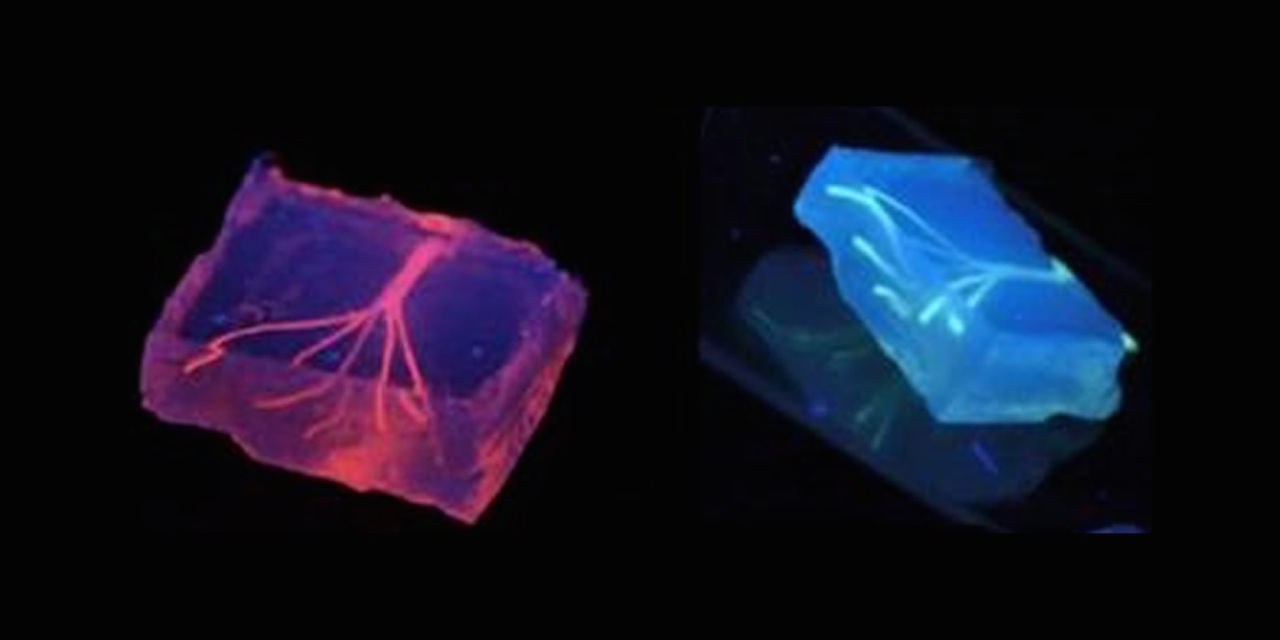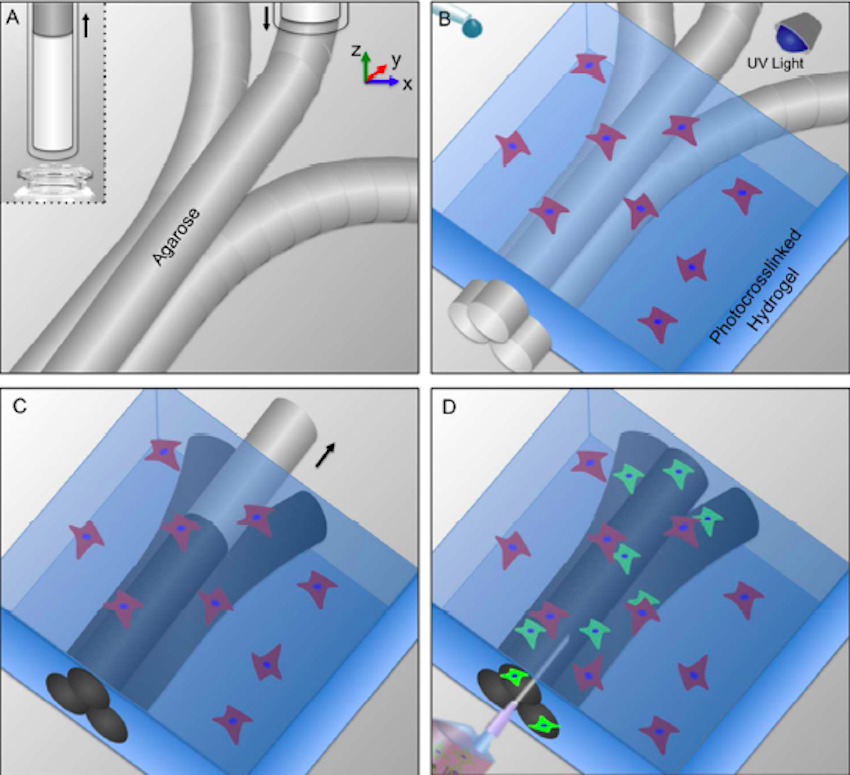Bio-printing transplantable tissues and organs is now a step closer
July 1, 2014

Photograph of 3D branching agarose template embedded in a hydrogel construct (blue) and resulting blood-vessel-like 3D branching network (red). Scale bar: 3 mm. (Credit: University of Sydney)
Scientists from the Universities of Sydney, Harvard, Stanford, and MIT have bio-printed artificial vascular networks mimicking the body’s circulatory system.
These networks are necessary for growing large complex transplantable tissues and organs for people affected by major diseases and trauma injuries.
“Thousands of people die each year due to a lack of organs for transplantation,” says study lead author and University of Sydney researcher Luiz Bertassoni. “Many more are subjected to the surgical removal of tissues and organs due to cancer, or they’re involved in accidents with large fractures and injuries.
“Imagine being able to walk into a hospital and have a full organ printed — or bio-printed, as we call it — with all the cells, proteins and blood vessels in the right place, simply by pushing the ‘print’ button in your computer screen. We are still far away from that, but our finding is an important new step towards achieving these goals.
“At the moment, we are pretty much printing ‘prototypes’ that, as we improve, will eventually be used to change the way we treat patients worldwide.” The research challenge was networking cells with a blood supply. Cells need ready access to nutrients, oxygen and an effective “waste disposal” system to sustain life. That’s why “vascularization” — a functional transportation system — is central to the engineering of biological tissues and organs.
“One of the greatest challenges to the engineering of large tissues and organs is growing a network of blood vessels and capillaries,” says Bertassoni. “Cells die without an adequate blood supply because blood supplies oxygen that’s necessary for cells to grow and perform a range of functions in the body.”
“To illustrate the scale and complexity of the bio-engineering challenge we face, consider that every cell in the body is just a hair’s width from a supply of oxygenated blood. Replicating the complexity of these networks has been a stumbling block preventing tissue engineering from becoming a real world clinical application.”
The research achievement

Schematic representation of bioprinting of agarose (a polysaccharide obtained from agar) template fibers and subsequent formation of microchannels via template micromolding. A) A bioprinter equipped with a piston fitted inside a glass capillary aspirates (draws by suction) the agarose (inset). After gelation (freezing to convert to gel) at 4 degrees C, agarose fibers are bioprinted at predefined locations. B) A hydrogel precursor is casted over the bioprinted mold and photocrosslinked. C) The template is removed from the surrounding photocrosslinked gel. D) Fully perfusable microchannels are formed. (Credit: University of Sydney)
Using a bio-printer, the researchers fabricated a multitude of interconnected tiny fibers to serve as the mold for the artificial blood vessels. They then covered the 3D printed structure with a cell-rich protein-based material, which was solidified by applying light to it.
Lastly they removed the bio-printed fibers to leave behind a network of tiny channels coated with human endothelial cells, which self-organized to form stable blood capillaries in less than a week.
The study reveals that the bioprinted vascular networks promoted significantly better cell survival, differentiation, and proliferation compared to cells that received no nutrient supply.
According to Bertassoni, a major benefit of the new bio-printing technique is the ability to fabricate large three-dimensional micro-vascular channels capable of supporting life on the fly, with enough precision to match individual patients’ needs.
“While recreating little parts of tissues in the lab is something that we have already been able to do, the possibility of printing three-dimensional tissues with functional blood capillaries in the blink of an eye is a game changer,” he says.
“Of course, simplified regenerative materials have long been available, but true regeneration of complex and functional organs is what doctors really want and patients really need, and this is the objective of our work.
Abstract of Lab on a Chip paper
Vascularization remains a critical challenge in tissue engineering. The development of vascular networks within densely populated and metabolically functional tissues facilitate transport of nutrients and removal of waste products, thus preserving cellular viability over a long period of time. Despite tremendous progress in fabricating complex tissue constructs in the past few years, approaches for controlled vascularization within hydrogel based engineered tissue constructs have remained limited. Here, we report a three dimensional (3D) micromolding technique utilizing bioprinted agarose template fibers to fabricate microchannel networks with various architectural features within photocrosslinkable hydrogel constructs. Using the proposed approach, we were able to successfully embed functional and perfusable microchannels inside methacrylated gelatin (GelMA), star poly(ethylene glycol-co-lactide) acrylate (SPELA), poly(ethylene glycol) dimethacrylate (PEGDMA) and poly(ethylene glycol) diacrylate (PEGDA) hydrogels at different concentrations. In particular, GelMA hydrogels were used as a model to demonstrate the functionality of the fabricated vascular networks in improving mass transport, cellular viability and differentiation within the cell-laden tissue constructs. In addition, successful formation of endothelial monolayers within the fabricated channels was confirmed. Overall, our proposed strategy represents an effective technique for vascularization of hydrogel constructs with useful applications in tissue engineering and organs on a chip.